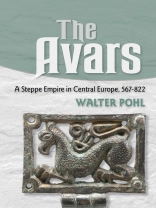‘Though the book was first published in German in 1988, this English version includes many revisions and updates and will be the definitive English-language study of the Avar empire for years to come. It will be invaluable for those interested in medieval history or in the impact of nomadic steppe empires on sedentary civilizations.’— Choice
The Avars arrived in Europe from the Central Asian steppes in the mid-sixth century CE and dominated much of Central and Eastern Europe for almost 250 years. Fierce warriors and canny power brokers, the Avars were more influential and durable than Attila’s Huns, yet have remained hidden in history. Walter Pohl’s epic narrative, translated into English for the first time, restores them to their rightful place in the story of early medieval Europe.
The Avars offers a comprehensive overview of their history, tracing the Avars from the construction of their steppe empire in the center of Europe; their wars and alliances with the Byzantines, Slavs, Lombards, and others; their apex as the first so-called barbarian power to besiege Constantinople (in 626); to their fall under the Frankish armies of Charlemagne and subsequent disappearance as a distinct cultural group. Pohl uncovers the secrets of their society, synthesizing the rich archaeological record recovered from more than 60, 000 graves of the period, as well as accounts of the Avars by Byzantine and other chroniclers.
In recovering the story of the fascinating encounter between Eurasian nomads who established an empire in the heart of Europe and the post-Roman Christian cultures of Europe, this book provides a new perspective on the origins of medieval Europe itself.
Содержание
List of Maps
Timeline
Preface
1. Approaching the Avars
1.1. Marginal Europeans?
1.2. Sources and Prejudices
1.3. Steppe Research and Its Methodological Problems
2. The Avar Migration
2.1. Constantinople 558
2.2. The Empire and the Steppe Peoples
2.3. Fugitives from the East
2.4. Avars or Pseudo-Avars?
2.5. The Advance of the Avars
2.6. Byzantium and the Turks
2.7. The Discovery of Europe
2.8. Decisive Years
2.9. 568: A Turning Point
3. The New Power, 567–90
3.1. The First Attack on Sirmium
3.2. Between Peace and War
3.3. Baian’s Alliance with Byzantium
3.4. The Conquest of Sirmium
3.5. 583/84: Avar Raids and Symbolic Politics
3.6. 585/86: Slavic Raids and the Bookolabras Affair
3.7. 587: The War in Thrace
3.8. The Carpathian Basin in the Later Sixth Century: The Archaeological Evidence
3.9. Cultures around Keszthely
4. Avars and Slavs
4.1. Slavs before the Avars: Perceptions and Origins
4.2. The Saint and the Barbarians
4.3. Slavic Campaigns and Memories of Avars on the Greek Peninsula
4.4. The Obor and His Slavs
4.5. Avar Rule and Slavic Expansion
4.6. Becoming Slavs
5. The Balkan Wars of Maurice, 591–602
5.1. Maurice’s Campaign and the Date of the Wars
5.2. The Avars on the Offensive
5.3. 593: Attacks on the Slavs North of the Danube
5.4. 594: The Limits of the Slavic War
5.5. 595: The Illyrian War
5.6. The Avars’ Western Policy and the Slavs
5.7. 598: Only the Plague Can Stop the Avars
5.8. 599: The Khagan under Pressure
5.9. 600–602: The End of Imperial Politics on the Danube
6. Life and Organization in the Avar Empire
6.1. Nomads, Warriors, Steppe Peoples
6.2. ‘Their Life Is War’
6.3. The Early Avar Khaganate
6.4. The Avars and Byzantium
6.5. Avar Gold: Prestige, Gifts, Representation
6.6. Logades and Warriors
6.7. Forms of Production and Distribution
6.8. Exchanges and Their Limits
6.9. Religion and Ritual
6.10. The Development of Identities in the Avar Empire
7. The Seventh Century
7.1. Consolidation and New Offensives
7.2. The Surprise Attack on the Emperor
7.3. 626: The Siege of Constantinople
7.4. Samo
7.5. Croat Migrations?
7.6. Alciocus and Kuvrat
7.7. Kuver and Asparukh
7.8. Continuity and Cultural Change
8. The Century of the Griffin
8.1. Ways of Life in Archaeological Evidence
8.2. The Hierarchy of the Late Avar State
8.3. Limes Certus: The Avars and the West
8.4. The Collapse of Avar Power
8.5. Why Did the Avars Disappear?
8.6. Conclusion
Appendix: Amount of Subsidies Paid by Byzantiumto the Avars
Abbreviations
Notes
Sources
Bibliography
Index
Об авторе
Walter Pohl is Professor Emeritus of Medieval History at the University of Vienna, Fellow of the Medieval Academy of America, and was Director of the Institute of Medieval Research at the Austrian Academy of Sciences. He is the editor of Medieval Worlds, coeditor of Emerging Powers in Eurasian Comparison, and author of numerous books in German.












